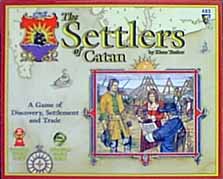

|
| Courtesy of Funagain Games |
First, let me explain the mechanics of the game. The game board is created by shuffling rather large (10 cm) hexagonal tiles and laying them in a circular pattern. The first three rings including the center are land tiles, surrounded by a fourth ring of sea tiles containing several types of ports for trading. (Later Settlers games broke this pattern, and variant games have experimented with all type of board layouts.) The land tiles represent the 5 main staples of the Settlers economy: wheat, wool, brick, lumber, and ore. There is also 1 barren desert hex. After the board tiles have been placed, a set of tokens is placed on the land tiles in an order that determines the land production value. The value is merely a number from 2 to 12, when rolled produces the raw material represented by the hex tile.
To begin each player places 2 settlements and 2 roads on the board. Interestingly, these pieces are placed on the apexes and edges of hex tiles, rather than in the center as with many other games. This creates the potential for one tile to affect many bordering pieces - a genius idea! On each turn a player rolls 2 dice for production, with any settlement bordering on the productive land receiving a commodity. Given enough commodity cards, the player can then purchase roads, more settlements, or upgrade a settlement to a city.
A production roll of 7 causes the evil Robber Baron to leave the barren desert hex and visit the Settlers. First, the Robber steals half of the commodity cards of any player who has more than 7 cards. Second, the Robber temporarily turns the land he is visiting into a non-productive land. Finally, the Robber allows the placing player to steal a card from one of the bordering settlements. This Robber is certainly a nuisance in the land of Catan.
The player can also purchase development cards which come in several flavors:
Each turn consists of rolling for production, trading with opponents or port sites, building stuff, and passing the dice. A game ends when a player reaches 10 victory points. The enjoyment of the game comes from watching the board develop, trading with your opponents, and feeling the tension as players get nearer and near to the victoy conditions.
Apparently, Settlers has quite a few other fans out there, as both Kosmos and the American publisher Mayfair have made a mini-gaming industry out of this title. From Kosmos we have:
From Mayfair we have:

|
| Courtesy of Funagain Games |
Another jewel of a creative thought comes in the simultaneous handout of commodities. Most other games would have had the turn sequence affect only the current player. Settlers has the brilliant idea of having the production roll affect ALL players. So with every turn, each player is interested in seeing what fields are producing and what purchases become available. Each production roll may affect more than one hex (the 6 for example), and each hex may have potentially 3 cities on the borders. Certain rolls may affect up to 6 players! During the turn, every player also considers whether to trade with the current player. This keeps all player active and following the results of every turn. Fun. So it is easy for me to see the wild popularity of the Settlers games: varying boards, interesting placements on the boards, continual interaction.
But what are some of the down sides? Some players berate Settlers for the frequent use of the dice in determining production. Personally, I don't think this is a reason to call Settlers a luck-based, as some have. The sheer number of rolls and the law of averages mitigates the game-disturbing luck element. In general, a Settlers board will produce more 6 commodities than 12 based commodities. However, if the gods of chance determine that the 12 brickyard suddenly produce for 10 turns in a row, then so be it. Let that Settler build roads, for the luck is with them!
My main complaint about Settlers is the high value of initial placements. I think almost 50 percent of the game is played in the initial placements with bad placements being impossible to overcome, and good placements leading to near victories. There will be games in which a player (especially the fourth player who places settlements in the 4th and 5th order) will not be able to find a good placement for the initial settlements. The rest of the game tends to be boring and excrutiating as one roll after another passes by with little income and little building. It hurts to see the others race toward 10 victory points, while you are sitting there with your villages producing little and the Robber Baron walking all over you. Hopefully newer players learn this, and veteran players understand this.
There are many expansion sets for the Settlers fan. I have purchased the 5-6 player expansion and believe it works very well, although the golden number of players is still 2 or 3. A 6 player game is fun with the additional ring of land tiles, but the interaction goes down a little. A rule change allows all 6 players to trade to prevent the Robber from collecting taxes too often. I also find the variant board layouts exciting especially when the new sets are mixed in to create strange and wonderful boards. I have also bought the Settlers Card Game and shall write a review soon, although I can omnisciently say it will not be as positive as this. As of this writing (December 1998), I have not yet played the Seefahrers or Städte und Ritter, but I intend to buy them and report on them in a separate review.
Also Kulkmann's G@meBox offers a solitaire computer version of Settlers that works very well. The computer game plays the basic game very well, and I am particularly impressed with the intelligence of the computer players: the settlement placements make sense, the trading is logical, and rarely have I seen the computer make a bad move. Not bad for a freeware game! (Contrast this with the horrible computer plays and the corrupt uselessness of multiplayer gaming with Hasbro's Axis & Allies, an absolute stinker of a computer implementation.) I am glad for the popularity of Settlers for it has lead to all these wonderful variations on the central theme.
Many games have a good idea. Often the novel is surrounded by a plethora of tried and true methods. At other times with other games, there is a visible strain of someone trying to fit an idea into a game that does not quite work. Settlers, on the other hand, is lucky enough to have 2 or 3 novel ideas that fit cohesively AND form an enjoyable game. Because of this, I think many game players will use Settlers as a touchstone for comparision and a must have in the gaming closet. Highest ratings.
Also see the review of The Seafarers of Catan.